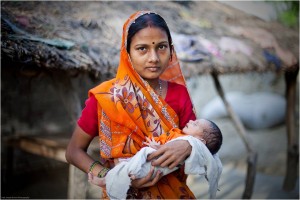
© Paul Joseph Brown/GAPPS
Projects seek to undercover how the following conditions lead to preterm birth, low birth weight and stillbirth:
- Malaria infections of the placenta
- Infections of the female reproductive tract
- Disruption of the normal bacteria and other micro-organisms of the lower female genital tract
- Body’s receptors for progestin-based therapies
- Infections that cause inflammation in the uterus
Dr. Kevin Kain had completed medical school and was about to embark on a career as a surgeon in Canada, but on a whim he and some friends decided to take a trip to Africa.
He ended up spending a year driving the entire length of the continent, camping along the way. “I was immediately struck that people were dying from diseases all around me that I had never even been taught about,” he says.
He returned to North America and decided to devote his career to global health. “It seemed this incredible inequity in education about what the major burdens of disease were in the world and that we didn’t know anything about them. I got very passionate about learning about them and then wanting to do something about them.”

Kain is now the Director of Sandra A. Rotman Laboratories at the Sandra Rotman Centre, as well as a professor of medicine at the University of Toronto and Senior Scientist at the University Health Network. He is also one of five principal investigators whose research project into preventing preterm birth was announced today by the Global Alliance to Prevent Prematurity and Stillbirth (GAPPS), an initiative of Seattle Children’s. The projects are funded through the Preventing Preterm Birth initiative, part of the Bill & Melinda Gates Foundation’s Grand Challenges in Global Health. The initiative seeks to discover biological mechanisms that lead to preterm birth and develop innovative strategies for prevention.
There are 15 million babies born prematurely every year, with more than 1 million of those babies dying in infancy. As a result, prematurity is the leading cause of death in newborns and the second-leading cause of death in all children under age 5.
Kain and his team of researchers will be investigating malaria infections of the placenta to reveal specific roles of the immune response that lead to preterm birth, low birth weight, and stillbirth. The project will focus on discovering biomarkers to identify at-risk pregnancies as well as new interventions to prevent adverse pregnancy outcomes.
“Our goal is to try and understand why preterm births occur, what we can do to prevent them, and how we can allow a child to make it to their 5th birthday,” Kain says. “Diseases like malaria may trigger preterm birth at a high frequency, and if we understand how it does it, we may understand how those problems occur, which would be applicable to helping improve birth outcomes worldwide.”
Along with Dr. Kain, four more awards were announced today as part of the Preventing Preterm Birth initiative:
- Dr. David Aronoff of the University of Michigan, with an interdisciplinary team of experts in microbiology, immunology, reproductive biology, and vaccine development, will examine how infections of the female reproductive tract interact with and evade the immune system, resulting in infections of the uterus that cause preterm birth and stillbirth. This work will research potential targets for prevention of invasive infections of the female genital tract, including plans to investigate strains of group B Streptococcus (GBS) from low-income countries for vaccine and drug development.
- Dr. Margaret Hostetter from Cincinnati Children’s Hospital Medical Center and her co-investigators will examine how disruption of the normal bacteria and other micro-organisms (the microbiome) of the lower female genital tract may increase risk of preterm birth. These investigations will focus on vaginal Candida infections in pregnancy, inflammation, and regulation of the immune response. Research will be conducted using animal models and laboratory investigations connected to studies of women in low-resource countries. Their goal is to investigate protective and pathogenic mechanisms of preterm birth and identify novel treatment strategies for vaginal fungal infections to prevent preterm birth.
- Dr. Sam Mesiano from Case Western Reserve University School of Medicine and his team will investigate the body’s receptors for progestin-based therapies in pregnancy to identify ways to enhance anti-inflammatory processes in all pregnant women and prevent preterm birth. The long-term goal of this project is to develop an inexpensive oral therapy that will reduce the prevalence of preterm birth worldwide.
- Dr. David Olson from the University of Alberta will be working to better understand how infections can cause preterm birth. Using animal models and in later studies of women in low-income countries, he and his team will investigate multiple mediators of inflammation in the uterus early in pregnancy, as well as test new diagnostics and therapeutics that can identify women at risk, modulate the inflammatory response, and prolong pregnancy.
Supporting Materials
- Preventing Preterm Birth Initiative New Project Press Release: http://www.seattlechildrens.org/media/press-detail.aspx?id=505566
- About Preventing Preterm Birth initiative: www.gapps.org/healthybirth
- Preventing Preterm Birth Initiative Initial Announcement in November 2011: http://www.seattlechildrens.org/Press-Releases/2011/Quest-to-End-Premature-Births-Worldwide-Takes-Momentous-Step-Forward/

